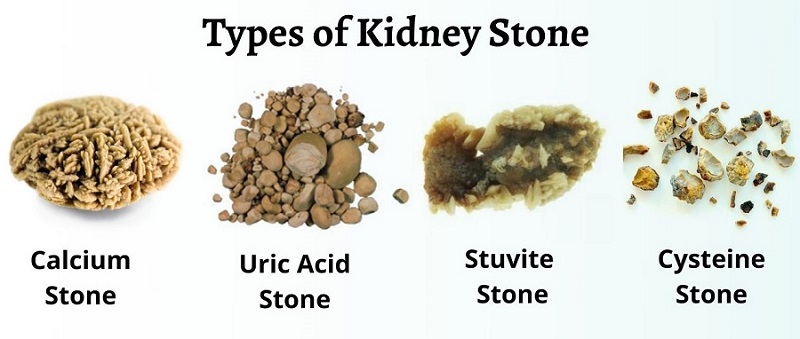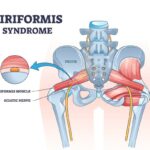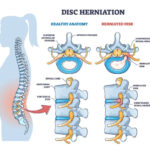What is Kidney Stone?
A kidney stone is an irregularly shaped solid mass or crystal that can be as small as a grain of sand or the size of a golf ball. Depending on the size of the kidney stone or stones, a person may not even realize they have one. Even small stones can cause extreme pain as they leave the body through the urinary tract. Drinking fluids can help this process, which can take up to three weeks.
A large kidney stone can become stuck in the ureter (the tube that drains urine from the kidney to the bladder). When this happens, the stone can cause bleeding and block urine from leaving the body. Surgery may be required for a stone that cannot pass on its own.
Why Do Kidney Stones Occur?
More than one factor plays a role in the formation of kidney stones. The presence of more than one factor may increase the risk of kidney stone formation.
-
Insufficient Amount of Fluid Intake:
Lack of sufficient water in the body has a significant effect on the formation of kidney stones. Not drinking enough water during the day increases the concentration of stone precursor substances excreted in urine. However, it can make the urine acidic. This situation causes kidney stone formation.
-
Gender:
More kidney stones occur in men than in women.
-
Genetics:
Having kidney stones in the individual’s family genetically predisposes them to kidney stone formation.
- Patients who have had kidney stones before have a high probability of developing kidney stones again. This condition is more common, especially in patients who had it before the age of 25.
- Our diet is another reason for kidney stone formation. A diet high in protein, sodium and sugar is one of the factors that cause this disease to occur.
- The incidence of this disease increases in people who have had digestive system surgery.
- Having only one kidney increases the risk of this disease.
- The possibility of kidney stone formation increases as a result of increased cystine, oxalate, calcium or uric acid levels in the urine.
- Medications used to reduce fluid accumulation also increase the risk of kidney stones.
- In people who have had many urinary tract infections, diseases such as Chron’s disease, hyperparathyroidism, medullary sponge kidney, renal tubular acidosis and dent disease may cause this disease.
- Using vitamin D and calcium pills increases the risk of kidney stones.
What are The Symptoms of Kidney Stones?
Very small stones can pass through the urinary tract and pass on their own. However, as its size increases, the stone has difficulty passing from the kidney to the bladder and may become stuck in the ureter. Depending on the location and size of the stone, patients generally begin to feel pain at this stage, and this pain is commonly described as “flank pain”.
So, what are the other symptoms of stone formation in the kidneys:
- Severe pain under, next to or behind the ribs
- Pain radiating to the lower abdomen and groin
- Pain that comes in waves and increases in intensity and pain when urinating
- Pink, red or brown colored urine
- Cloudy or foul-smelling urine
- Nausea and vomiting
- Constant need to urinate
- Urinating more frequently than normal
- Fever and chills
What are The Types of Kidney Stones?
Kidney stones are divided into the following types according to the minerals that make up the stone:
-
Calcium Stones:
They are stones formed by various compounds of calcium such as calcium oxalate and calcium phosphate. Approximately 75% of all kidney stone cases are calcium stones.
-
Uric Acid Stones:
It is a type of kidney stone that is generally seen in individuals who eat a high-protein diet.
-
Cystine Stones:
Although it is a rare type of kidney stone, it is usually caused by metabolic disorders.
-
Citruvite (Infection) Stones:
This type of stone, which usually results from urinary tract infections, can cause serious kidney damage in a short time due to its very rapid growth.
How Are Kidney Stones Diagnosed?
A detailed examination by a urologist is important in diagnosing kidney stones. The symptoms of kidney stones may be sufficient for the urologist in most cases. However, some tests can be performed to fully clarify the diagnosis of kidney stones.
-
Blood Test:
A blood test may be performed to check whether the kidneys are working properly. In particular, the rates of substances in the blood that may be effective in kidney stone formation, such as uric acid and calcium, are examined.
-
Urine Test:
The presence of blood and infection in the urine can be detected. Urine tests can provide important details to identify diseases that may accompany kidney stones and clarify the diagnosis.
Additionally, 1-day urine collection tests may be performed.
With a urine collection test, substances that may cause or prevent stone formation in the urine can be determined.
Imaging Methods:
Kidney stones can be diagnosed with imaging methods. Different methods can be used to diagnose kidney stones using imaging methods.
-
Computer Tomography:
The location and size of stones in the kidney or urinary tract, including small stones, can be determined. Computed tomography can also determine whether there is a different disorder in the kidney and surrounding organs.
-
Ultrasound:
Information about kidney stones can be obtained with the ultrasound method, which uses high-frequency sound waves. Fast and reliable results can be obtained. Very small stones and stones that have entered the urinary tract can sometimes be missed by ultrasound. However, ultrasonography is preferred for pregnant women to avoid exposure to radiation.
-
Intravenous Urogram (IVU) or Intravenous Pyelogram (IVP):
It is based on the principle of checking the filtering process of the kidneys with x-ray after intravenous administration of contrast material. However, it is not a preferred method in recent years.
-
Kidney Stone Analysis:
By taking a stone previously passed through urine to a urologist, the internal structure of the stone can be tested.
The excreted stone can be collected by urinating through gauze, socks or a strainer. Examining the stone in the laboratory gives the doctor an idea about the application of treatment that will prevent stone formation again.
How to Treat Kidney Stones?
Kidney stone treatment may vary depending on the location, size and type of the stone. Most kidney stones, especially 4 mm. Those smaller than 1.5 m can be eliminated from the body on their own through the urine. However, small kidney stones can also cause severe pain.
Applications that can be done at home for small kidney stones can be listed as follows:
-
Water:
Small stones in the kidney can naturally pass on their own if the patient drinks plenty of water. Drinking 2-3 liters of water during the day can be effective in cleansing the urinary tract and kidneys. People who consume enough water have clear urine colors. It is also desired to achieve this result in kidney stone treatment.
- Medicine:
In the treatment of kidney stones, using drugs that activate the muscles in the kidneys can help pass the stones more easily.
Medications can provide a more comfortable stone passing process. Painkillers can also be used due to the pain experienced during this process.
Different treatment methods are applied for stones that are too large to pass through the urinary tract.
-
Breaking Kidney Stones with Sound Waves (SWL):
Depending on the location and size of the kidney stone, shock wave therapy stone breaking method can be used.
Sound waves that create strong vibrations are used to break up kidney stones from outside the body. The broken kidney stone pieces are excreted from the body with urine.
The procedure may take 30-45 minutes depending on the size and location of the kidney stone and the device used.
Breaking the kidney stone with sound waves is performed under sedation or light anesthesia, as it is not very severe but can cause pain. The patient is sent home on the same day. The method of breaking kidney stones with sound waves, known as the non-surgical lithotripsy method, is generally successful in kidney stones smaller than 2 cm.
-
Flexible Ureterorenoscopy (Retrograde Intrarenal Surgery, Laser Stone Crushing)
With the help of bendable, flexible optical instruments, the stone is visualized by entering the urinary canal and proceeding to the bladder, ureter and kidneys, respectively. In this endoscopic surgery, which does not require any incision, after the stone is found, it is broken into pieces invisible to the naked eye using laser energy. Sometimes, repeated operations may be required due to the size of the stone, its location and stenosis in the urinary tract.
Again, as in the ureteroscopy method applied to ureteral stones, a catheter (double j stent) with one end bent in the bladder and the other end in the kidney is placed in the ureter to ensure urine drainage depending on the remaining stone volume and edema in the urinary system after the operation, and is removed after a few days or weeks. This method is generally preferred for kidney stones that are not very large (<2-3 cm) and stones located in the upper part of the ureter.
Being able to be discharged even on the same day, returning to work quickly (2-3 days), low complication rate, and high stone-free rate make this surgery advantageous compared to other alternative kidney stone surgeries (percutaneous nephrolithotomy, open surgery).
-
Percutaneous Nephrolithotomy (PCNL) Method:
Percutaneous Nephrolithotomy (PCNL) is a surgical method used to treat large or complex kidney stones within the kidney. Although this method is a minimally invasive technique, it is preferred in cases where simpler stone treatment methods such as ureteroscopic lithotripsy or ESWL are inadequate.
Percutaneous Nephrolithotomy (PCNL) method is an effective method used successfully in the treatment of large and complex kidney stones. However, since each patient’s situation is different, it is important to consult a urologist to determine the appropriate treatment option.
-
Open Kidney Stone Surgery:
Due to developing technology, open surgery for kidney stones is rarely performed today. It is applied to patients with a very large stone or abnormal anatomy.
In open kidney stone surgeries, which do not exceed 1%, the urologist reaches the kidney stones by making an incision on the back to reach the kidneys.
-
Hyperparathyroidism Surgery:
Excessive functioning of the parathyroid glands, which are the only organ that ensures that the calcium level in the blood remains within normal limits, may cause kidney stones to form. When these glands produce too much parathyroid hormone (hyperparathyroidism), calcium levels rise, predisposing to the formation of calcium stones. Surgery on the parathyroid glands can normalize calcium levels and prevent kidney stones.
Recommendations to Prevent Kidney Stone Formation Again
- The person should stay away from foods and drinks that will disrupt the acid-base balance in urine.
- He/she should consume 2.5 – 3 liters of fluid per day.
- The person should do plenty of exercise and be constantly in motion. If there is excessive salt consumption, it should be reduced because salt is the biggest enemy of the kidneys.
- Consuming foods high in fiber prevents the formation of kidney stones. Ready-made food and drinks should be avoided.
- In general, the person should pay attention to a vegetable-based diet.






